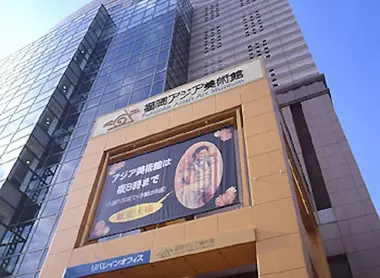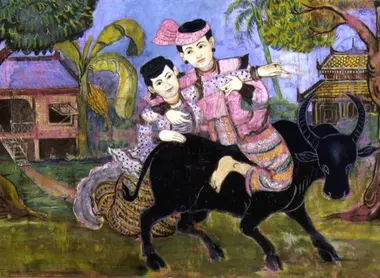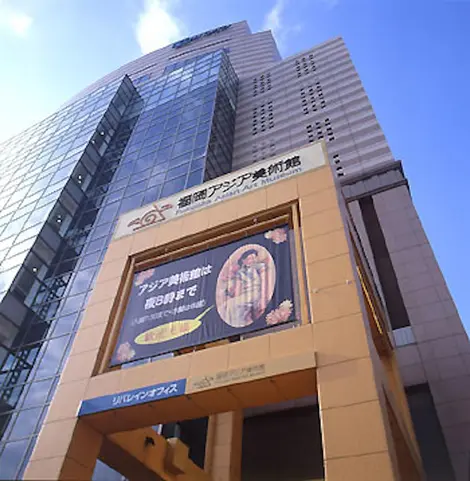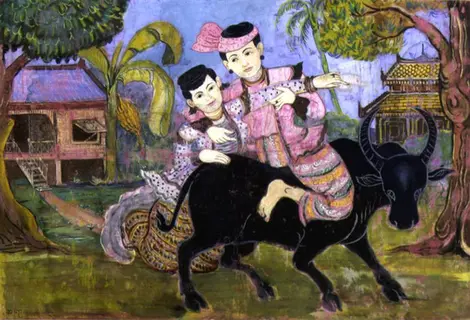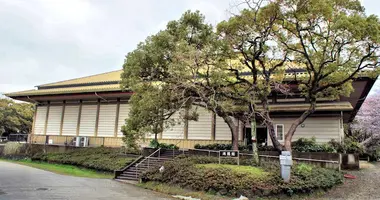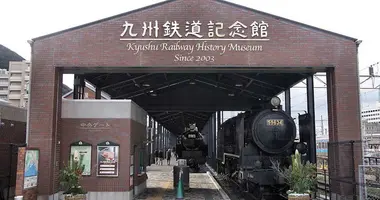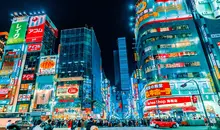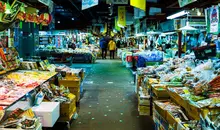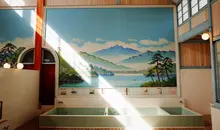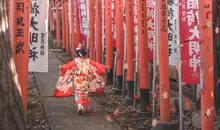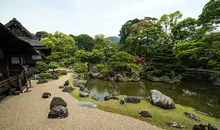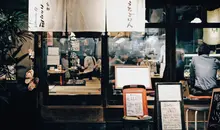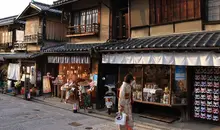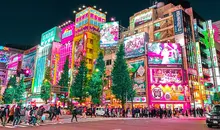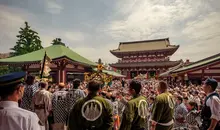Fukuoka Asian Art Museum: a treasure trove of contemporary Asian art
- Published on : 17/12/2014
- by : G.L.
- Youtube
Celebrating Asian Artists
Located in the heart of Fukuoka, the Fukuoka Asian Art Museum (FAAM) is a unique institution dedicated to contemporary Asian art. Opened in 1999, the museum plays a fundamental role in Japan's cultural landscape, serving as a bridge between Japan and its Asian neighbors. With an impressive collection of over 5,000 works from 23 Asian countries and regions, FAAM offers a comprehensive and diversified vision of the continent's contemporary artistic creation. Housed in the Hakata Riverain building, between the Tenjin and Hakata districts, the museum bears witness to Fukuoka's historic importance as a gateway for Asian cultural influences in Japan. Through its exhibitions, artist residencies and exchange programs, FAAM has established itself as a key player in international artistic dialogue in Asia.
Introducing the Fukuoka Asian Art Museum and its unique mission
The Fukuoka Asian Art Museum (FAAM), or 福岡アジア美術館 (Fukuoka Ajia Bijutsukan) in Japanese, has established itself as one of the few museums in the world - perhaps the only one - devoted entirely to contemporary Asian art. This is particularly significant in the context of Fukuoka, a city that has historically served as a gateway for Asian cultural influences in the Japanese archipelago. It was through this city that Buddhist arts and the Chinese writing system were once introduced, and it was in this region that Korean potters shared their techniques, notably the art of porcelain.
FAAM's mission is twofold: firstly, to preserve and present contemporary works of art from the various Asian nations, and secondly, to foster cultural exchange between Asian artists and the Japanese public. Unlike other institutions, which often focus on Western art or present Asian art from an exotic angle, FAAM strives to show the various forms of traditional Asian art in a modern light, without seeking to imitate Western trends. This approach enables visitors to discover artistic expressions that are often neglected in international art circuits.
With its strong regional focus, the museum plays a crucial role in promoting Asian artistic traditions while highlighting their contemporary evolution. As such, it is a privileged vantage point for observing the cultural dynamics running through the Asian continent, the social transformations it is undergoing, and the questions of identity that drive it in the face of globalization.
The permanent collection: 5,000 works from 23 Asian countries and regions
FAAM's permanent collection represents a priceless treasure trove, with over 5,000 works from 23 Asian countries and regions. This impressive collection is distinguished by both quantity and quality, offering a comprehensive panorama of contemporary Asian art from the 19th and 20th centuries. The display of works changes regularly, around eight times a year, enabling visitors to constantly discover new aspects of this rich collection.
What makes this collection particularly valuable is that it showcases works from countries often absent from major international museums. Visitors can admire Mongolian, Philippine and Burmese paintings, photographs from Singapore, installations by Cambodian artists and many other creations rarely exhibited elsewhere. Among the most famous artists represented at FAAM is Fang Lijun, the Chinese artist best known for his "Séries numéros 3" series, as well as other major creators such as Kim Tschang-Yeul (South Korea), Thawan Duchanee (Thailand) and Tserennadmidin Tsegmed (Mongolia).
The collection encompasses a wide variety of art forms: paintings, sculptures, installations, photographs, films and performances. It includes works that engage with centuries-old artistic traditions, as well as creations that explore resolutely contemporary techniques and themes. This diversity testifies to the richness and dynamism of artistic creation in Asia, a continent where age-old artistic practices coexist with the most avant-garde expressions.
For art lovers and the simply curious, exploring FAAM's collections is a unique opportunity to discover an often little-known facet of the world's artistic creation, and to take a fresh look at the cultural transformations taking place in contemporary Asia.
FAAM's temporary and thematic exhibitions
In addition to its permanent collection, FAAM offers a number of temporary and thematic exhibitions throughout the year, enriching its cultural offering and enabling visitors to delve deeper into certain aspects of contemporary Asian art. These exhibitions are carefully selected and organized along three main lines.
Firstly, the museum regularly presents national exhibitions focusing on the art of a particular country, offering an immersion into the art scene of a specific nation. These exhibitions highlight the cultural, historical and artistic particularities of each Asian country, while showing how artists are responding to their own contemporary issues. Secondly, FAAM organizes monographic exhibitions dedicated to the work of a specific artist, enabling an in-depth exploration of a creator's approach and universe. Finally, some exhibitions tackle cross-cutting themes on a pan-Asian scale, exploring how different Asian cultures deal with common issues.
The exhibition calendar is regularly updated on the museum's website, and announcements are published in the newsletter "あじびニュース" (Ajibi News), distributed free of charge within the museum. The newsletter contains detailed information on upcoming exhibitions, reports on cultural exchange projects and research in Asia, as well as news about Asian artists and researchers.
FAAM's temporary exhibitions provide an opportunity to discover works on loan from other prestigious institutions, as demonstrated by recent collaborations with Singapore's National Gallery and Japan's Tottori Prefectural Museum of Art. These loans contribute to the dynamic artistic exchange that the museum strives to promote on an international scale.
The artist residency program: supporting contemporary Asian creation
One of FAAM's most remarkable initiatives is its artist residency program, established when the museum opened in 1999. Initially designed to welcome Asian artists and researchers, this program was expanded in 2022 to include creators from all over the world, including Japan. This development reflects the museum's desire to foster international artistic exchange while remaining rooted in Asian creation.
The residency program takes place over three distinct periods during the year: July to September (approx. 85 days), October to December (approx. 80 days) and January to March (approx. 60 days). Each year, around seven artists or groups of artists are selected to take part in this program, including four from abroad, one or two from Japan, and one or two from the Fukuoka region. Selection is based on an international call for applications, generally open between October and November for the following year.
During their stay in Fukuoka, artists in residence benefit from substantial financial and logistical support: international and domestic travel costs, accommodation, allowance for daily expenses, budget for artistic creation and exhibition (up to 500,000 yen), funding for artistic exchange programs, and insurance for exhibited works. In return, they commit to creating new works inspired by their environment in Fukuoka, organizing two workshops and two lectures for the local public, and presenting the fruits of their labor at an exhibition or open workshop.
This program not only enables artists to develop their practice in a new environment, but also to establish collaborations with local art professionals and universities. For the people of Fukuoka, these residencies offer a unique opportunity for direct interaction with international creators, contributing to a better understanding of contemporary art, Asian art and the different cultures represented.
Activity reports from the artistic residencies are regularly published and available on the museum's website, testifying to the wealth of cultural exchanges facilitated by this innovative program.
Practical information: opening times, access and prices
The Fukuoka Asian Art Museum (FAAM) is located in the Hakata Riverain building, at 3-1 Shimokawabata-machi, in the Hakata district of Fukuoka. The museum occupies the 7th and 8th floors of this modern complex, located between the Tenjin and Hakata districts, near Nakasu Island.
Museum opening hours are from 10 a.m. to 8 p.m. every day, except Wednesday (weekly closing day). Last admission is accepted until 7.30pm. The museum is also closed during the Japanese New Year.
Access to the museum is particularly easy thanks to its central location. The nearest subway station is Nakasu-Kawabata (exit no. 6), just below the Riverain building. This station is served by the Kuko line, which takes you to the museum in just 2 minutes from Hakata station (200 yen) or 4 minutes from Tenjin (also 200 yen).
Entrance fees are very affordable: admission to the permanent collection costs just 200 yen for adults (approx. €1.30), while children up to middle-school age can enter free of charge. Special rates may apply for temporary exhibitions. This low price makes contemporary Asian art accessible to all, and reflects the museum's commitment to democratizing access to culture.
For further information or questions, visitors can contact the museum by telephone on +81 (0) 92-263-1100 or visit the official website: http: //faam.city.fukuoka.lg.jp/eng/home.html. The site offers information in several languages, including English, making it easier for international tourists to prepare their visit.
The museum's architecture and integration into the Hakata Riverain building
The Fukuoka Asian Art Museum (FAAM) is housed in the Hakata Riverain building, a modern complex located in the heart of Fukuoka, between the lively Tenjin and Hakata districts. Opened in 1999, the museum occupies the 7th and 8th floors of this contemporary building, giving it a privileged position in the city's urban landscape.
The museum's architecture is characterized by bright, functional spaces specially designed for the presentation of contemporary works of art. The vast, modular exhibition halls allow great flexibility in the scenography of permanent collections and temporary exhibitions. This architectural adaptability is perfectly suited to the varied needs of presenting different forms of contemporary Asian art, whether paintings, sculptures, monumental installations or digital works.
The Hakata Riverain building itself is a multi-purpose center that houses not only the museum, but also commercial spaces, restaurants and offices. This integration of FAAM into a mixed-use complex encourages the circulation of visitors and helps to desacralize access to contemporary art. Its immediate proximity to the Tenchika underground shopping mall (天神地下街) creates continuity between commercial and cultural spaces, naturally embedding the museum in the daily lives of Fukuoka's residents.
The building's geographical location, on the banks of the Hakata River, is not insignificant. It echoes the museum's vocation as a place of passage and exchange between cultures, in the image of Fukuoka, which has historically served as a meeting point between Japan and the rest of Asia. Indeed, the very name Riverain evokes this notion of a river's edge, a fluid and permeable frontier, perfectly symbolizing FAAM's mission as a cultural bridge between different artistic traditions.
Unlike other emblematic Fukuoka buildings, such as Acros Fukuoka with its impressive 60-metre plant wall, the architecture of Hakata Riverain favours functionality and urban integration over spectacular architectural gesture. This architectural sobriety highlights the works on display and creates an environment conducive to the contemplation and discovery of contemporary Asian art.
FAAM's cultural importance in Japan's artistic landscape
The Fukuoka Asian Art Museum occupies a unique and essential place in Japan's cultural landscape as an institution entirely dedicated to contemporary Asian art. This specialization gives it a strategic role in the artistic dialogue between Japan and its Asian neighbors, at a time when geopolitical relations in the region are sometimes complex and tense.
Historically, Fukuoka has always been a privileged point of entry for continental cultural influences in Japan. By establishing FAAM in the city, the Japanese authorities have recognized and reinforced this historic role. The museum is thus part of a long tradition of cultural exchange, while at the same time giving it a contemporary and institutional dimension. This historical continuity gives FAAM a special legitimacy as a cultural mediator between Japan and the rest of Asia.
In a global context where contemporary art is still largely dominated by Western perspectives, FAAM plays a crucial role in the recognition and promotion of Asian artistic expression. By building up a collection of international stature and organizing high-quality exhibitions, the museum helps to assert the importance and diversity of contemporary Asian art on the world stage. In this way, it contributes to a geographical and cultural rebalancing of the art world, offering an alternative to the circuits dominated by Europe and North America.
FAAM's artist residency program also plays a fundamental role in the development of transnational artistic networks in Asia. By facilitating encounters between artists from different countries, providing material support for their work and disseminating their works, the museum plays an active role in the emergence of a pan-Asian artistic community. These exchanges feed into a shared reflection on the contemporary challenges facing Asian societies, be they rapid urbanization, environmental transformations, colonial legacies or the tensions between tradition and modernity.
For Fukuoka residents and Japanese visitors alike, FAAM offers an irreplaceable window on the cultural diversity of the Asian continent. Through contemporary art, the museum enables visitors to discover different perspectives on shared issues, thus contributing to greater mutual understanding between the peoples of the region. In a Japan sometimes perceived as culturally isolated, despite its economic power, this opening onto Asia represents a considerable enrichment of the national artistic landscape.
Address, timetable & access
Address
Phone
+81 (0) 92-263-1100Timetable
Every day except Wednesday 10 am - 8 pm (last admission 7.30 pm)Price
adults 200 円
free for childrenAccess
Nakasu-Kawabata subway, exit # 6Website
http://faam.city.fukuoka.lg.jp/eng/home.html
